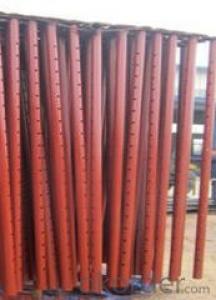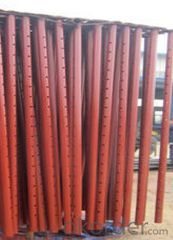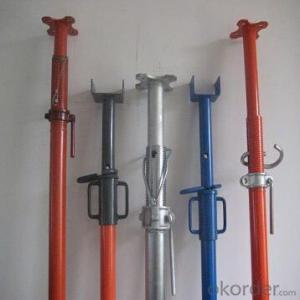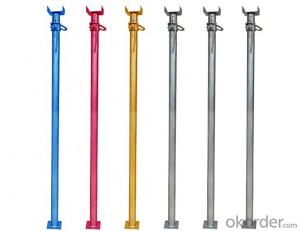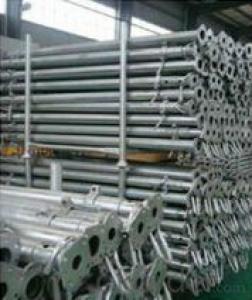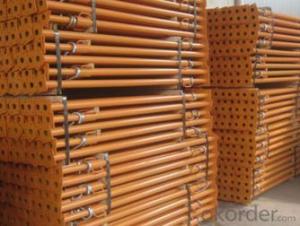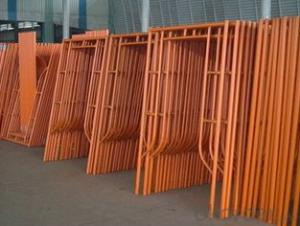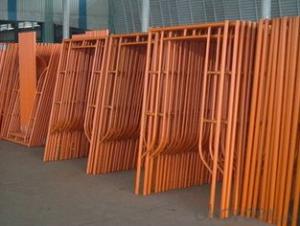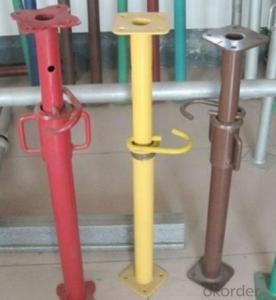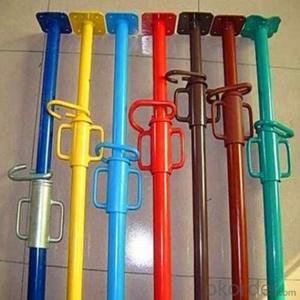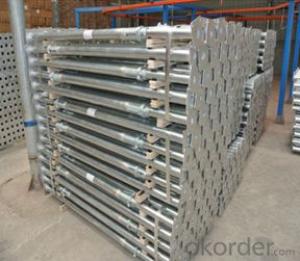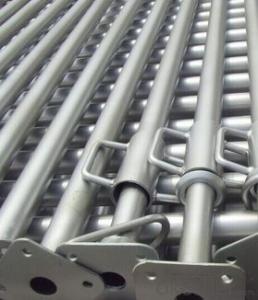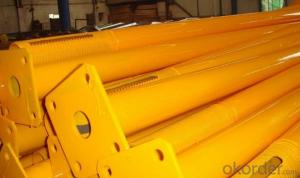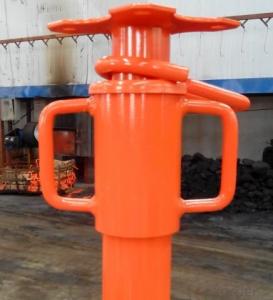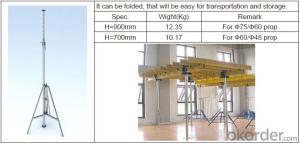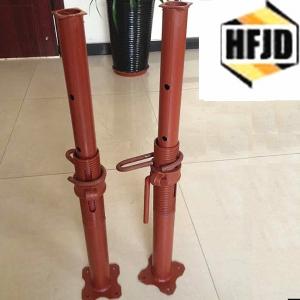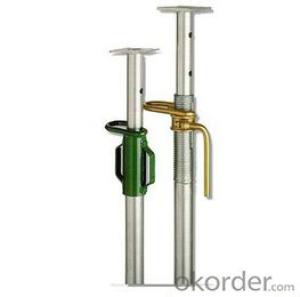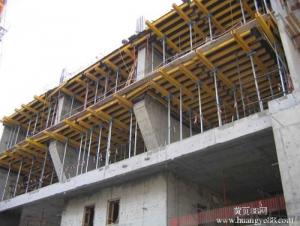Adjustable Steel Prop Scaffolding
- Loading Port:
- China Main Port
- Payment Terms:
- TT OR LC
- Min Order Qty:
- -
- Supply Capability:
- -
OKorder Service Pledge
OKorder Financial Service
You Might Also Like
Quick Details
| Pin: | Base Plate: | Packing: | |||
| Type: | Surface finished: | Material: | |||
| Certificate: | Safe load: | Distance between hole: | |||
| Max length: |
Packaging & Delivery
| Packaging Detail: | In bundles or as your request |
| Delivery Detail: | 20-25days |
Specifications
Adjustable Steel Prop Scaffolding
Surface:Dip-coating,painted
Material:Q235
Certificate:ISO9001-2008
Color:as your request
1 | OUTER TUBE | HR | 60±0.3x2(TH)±0.1 | 5 | BASE PLATE | SS-400 | 120x±1x5(TH)mm/±0.2 |
2 | INNER TUBE | HR | 48±0.3x2(TH)±0.1 | 6 | TOP PLATE | SS-400 | 120x±1x5(TH)mm/±0.2 |
3 | SCREW | SGP | 60±0.3x3(TH)±0.1 | 7 | FIXED PIN | S35C | 9~12±0.4 |
4 | ADJUSTING NUT | FCD | CASTING IRON | 8 | WIRE | SS41 | 12±0.2 |
MODEL | HT-V1 | HT-V2 | TH-V3 | HT-V4 |
Max length(mm) | 3,200 | 3,500 | 3,900 | 4,000 |
Min length(mm) | 1,945 | 2,120 | 2,520 | 2,600 |
Safety load | 1,370 | 1,250 | 1,100 | 980 |
No.of hole | 11 | 12 | 12 | 12 |
Distance Between(mm) | 125 | 125 | 125 | 125 |
Support
*Shoring for construction and civil engineering work
*Easy height adjustment
*Intensive durability and strength
*Simple and easier assemble and dismantle
- Q: Can steel props be used in both indoor and outdoor environments?
- Indeed, steel props are applicable in both indoor and outdoor settings. Steel, known for its adaptability and resilience, can endure diverse weather conditions, rendering it appropriate for outdoor utilization. Whether it entails bolstering temporary frameworks like scaffolding or formwork, or providing temporary assistance while undertaking construction or renovation ventures, steel props can be employed both indoors and outdoors. Furthermore, the corrosion-resistant qualities of steel guarantee its endurance and dependability, even in outdoor surroundings exposed to moisture or severe elements.
- Q: What are the alternatives to steel props for temporary support?
- There are several alternatives to steel props for temporary support in construction projects. Some of the common alternatives include: 1. Adjustable Props: These are similar to steel props but made from materials such as aluminum or lightweight alloys. They provide a temporary support system and can be easily adjusted to different heights. Adjustable props are lightweight, making them easy to handle and transport. 2. Timber Props: Timber props, also known as wooden props, are widely used in construction for temporary support. They are made from solid wood or engineered timber and provide a cost-effective alternative to steel props. Timber props are lightweight, easy to install, and can be easily cut to the required length. 3. Acrow Props: Acrow props are another popular alternative to steel props. They consist of an inner tube, an outer tube, a threaded rod, and a base plate. Acrow props are made from high-quality steel and provide adjustable support. They are commonly used in construction projects where temporary support is required. 4. Scaffolding: Scaffolding systems can also be used as an alternative to steel props for temporary support. They provide a versatile and safe working platform and can be easily adjusted to different heights. Scaffolding systems are made from various materials such as aluminum, steel, or composite materials. 5. Shoring Systems: Shoring systems are specifically designed to provide temporary support to structures during construction or repair work. These systems consist of vertical supports, horizontal beams, and adjustable struts. Shoring systems are commonly used in building construction, excavation works, and tunnel construction. 6. Hydraulic Jacks: Hydraulic jacks are another alternative to steel props for temporary support. They use hydraulic pressure to provide support to structures. These jacks are commonly used in applications where heavy loads need to be lifted or supported temporarily. It is important to consider the specific requirements of the project, such as load-bearing capacity, adjustability, ease of installation, and cost-effectiveness, when choosing an alternative to steel props for temporary support.
- Q: Are steel props suitable for supporting temporary trade show displays?
- Yes, steel props are suitable for supporting temporary trade show displays. Steel is a strong and durable material that can provide the necessary support and stability required for trade show displays. It is often used in construction and exhibition industries due to its reliability and ability to withstand heavy loads.
- Q: How do you choose the right size of steel prop for a specific project?
- Choosing the right size of steel prop for a specific project involves considering several factors. Here are some steps to guide you in making an informed decision: 1. Determine the load capacity: Start by calculating the maximum load that the steel prop will need to support. This involves assessing the weight of the structure or material being supported, including any additional loads such as equipment or workers. Consult with structural engineers or relevant professionals to accurately determine the load capacity required. 2. Evaluate the height requirements: Consider the height at which the steel prop needs to be set. Ensure that the prop's adjustable range covers the required height range. Take into account any potential adjustments that might be required during the project. 3. Assess the prop's dimensions: Consider the dimensions of the steel prop, including its diameter and wall thickness. These factors influence the prop's strength and stability. Ensure that the chosen prop size can withstand the anticipated loads and provide sufficient support for the project. 4. Consider the prop's material grade: Steel props are available in different material grades, which determine their strength and durability. Evaluate the project's requirements and select a prop with an appropriate material grade that meets the necessary load-bearing capacity and safety standards. 5. Check for certifications and standards compliance: Verify that the steel prop you choose complies with relevant industry standards and has the necessary certifications for quality assurance. This ensures that the prop is manufactured to the required specifications and will perform reliably during the project. 6. Seek expert advice: If you are unsure about any aspect of choosing the right size of steel prop for your specific project, it is advisable to consult with structural engineers, contractors, or suppliers who have expertise in this area. They can provide valuable guidance and help you make an informed decision based on the project's unique requirements. By considering these factors and seeking expert advice when needed, you can ensure that you choose the right size of steel prop for your specific project. This will help maintain safety, structural integrity, and efficiency throughout the construction process.
- Q: Can steel props be used for temporary support in residential buildings?
- Yes, steel props can be used for temporary support in residential buildings. Steel props are commonly used in construction to provide temporary support during building works, renovations, or repairs. They are adjustable and can bear heavy loads, making them suitable for providing temporary support in residential buildings where additional support is needed.
- Q: Can steel props be used in the construction of temporary educational or classroom facilities?
- Yes, steel props can be used in the construction of temporary educational or classroom facilities. Steel props provide strong structural support and stability, making them suitable for temporary structures such as classrooms. They can be easily adjusted and are capable of withstanding heavy loads, ensuring the safety and durability of the facilities.
- Q: What are the common maintenance requirements for steel props in harsh environments?
- In harsh environments, steel props require regular maintenance to ensure their longevity and functionality. Some common maintenance requirements for steel props in such conditions include: 1. Cleaning: Regular cleaning is essential to remove dirt, debris, and other contaminants that may accumulate on the surface of the props. This can be done using a mild detergent or a suitable cleaning solution, along with a soft cloth or brush. It is important to avoid using abrasive materials or harsh chemicals that can potentially damage the steel surface. 2. Inspection: Regular visual inspections should be conducted to assess the condition of the props. This involves checking for any signs of corrosion, rust, or damage. Inspections should also include a thorough examination of critical components such as pins, nuts, and bolts, ensuring they are secure and functioning properly. 3. Lubrication: Lubrication of moving parts is crucial to prevent friction and ensure smooth operation. Applying a suitable lubricant to hinges, joints, and other moving parts helps to reduce wear and tear, as well as prevent rust and corrosion. It is recommended to use lubricants that are specifically designed for steel or metal surfaces. 4. Rust prevention: In harsh environments, steel props are more susceptible to rust and corrosion. Applying a protective coating or paint can help prevent the penetration of moisture and chemicals that can lead to rust formation. Regularly inspecting the coating for any signs of damage or wear and promptly repairing or repainting as necessary will help maintain the protective barrier. 5. Storage and transportation: Proper storage and transportation practices are essential to prevent damage to steel props. They should be stored in a dry, well-ventilated area to avoid exposure to moisture and humidity. When transporting, care should be taken to prevent impact or vibration that can lead to dents or deformation. 6. Replacement of worn components: Over time, certain components of steel props may wear out or become damaged. It is important to replace these components promptly to maintain the overall integrity and safety of the props. This includes parts such as pins, nuts, bolts, and any other components that show signs of wear, corrosion, or damage. By following these common maintenance requirements, steel props can be effectively protected and preserved in harsh environments, ensuring their durability and reliable performance over an extended period of time.
- Q: What are the common safety certifications for steel props?
- The following safety certifications are common for steel props: 1. CE Marking guarantees compliance with the health, safety, and environmental protection standards of the European Union. It demonstrates that the product meets essential safety and performance requirements. 2. EN 1065 is a European standard that specifies the requirements and test methods for adjustable steel props in temporary structures. It ensures that the props can support loads safely and resist bending and buckling. 3. ANSI/ASSE A10.9 is an American National Standard that provides guidelines for designing, installing, inspecting, and using steel prop scaffolding systems. It ensures that the props are properly constructed and maintained for worker safety. 4. OSHA Compliance refers to meeting safety standards set by the Occupational Safety and Health Administration in the United States. Compliance ensures that steel props meet the necessary safety requirements for construction sites. 5. ISO 9001 certification indicates that the manufacturer has implemented a quality management system and follows strict quality control procedures. It ensures that steel props are consistently produced to meet customer requirements and safety standards. These certifications guarantee the safe and reliable manufacturing, testing, and use of steel props, reducing the risk of accidents and promoting worker safety on construction sites.
- Q: What is the pre - steel brace
- When it comes to brace generally refers to Rachel steel purlin, it is reinforced, but also to enhance the stability of the purlin purlin, not easy to lose in the external force under certain failure. Section purlin are generally H steel, C shape, Z shape, is reducing cabin panel span and fixed roof panel.The main specifications of steel support are Phi 400, Phi 580, phi, phi, phi, phi, phi, phi, and so on, and so on, and so on, and so on, and so on, and so on, and so on, and so on, and so on, and so on, and so on.
- Q: What are the main advantages of using telescopic steel props?
- Telescopic steel props offer several key advantages that make them a popular choice in construction and building projects. Firstly, one of the main advantages is their adjustable height feature. These props have a telescopic design, meaning their height can be easily adjusted to suit the specific requirements of a construction site. This adjustability allows for greater flexibility and efficiency during the construction process, as they can be used for various purposes and to support different structures at different heights. Another advantage of telescopic steel props is their strength and durability. These props are typically made from high-quality steel, which provides excellent load-bearing capacity. This strength allows them to support heavy loads and provide stability and safety on construction sites. Moreover, their durability ensures that they can withstand the harsh conditions often encountered during construction projects, such as extreme weather or rough handling. Additionally, telescopic steel props are easy to install and dismantle. Their design allows for quick and straightforward assembly, reducing the time and effort required for setup. This ease of use not only saves valuable construction time but also minimizes labor costs and improves overall project efficiency. Similarly, their dismantling process is equally efficient, making them ideal for temporary support needs or projects with changing requirements. Furthermore, telescopic steel props are highly versatile. They can be used in a wide range of applications, including shoring and propping of walls, floors, ceilings, and other structures. Their adaptability makes them suitable for various construction projects, such as building renovations, formwork support, or creating temporary scaffolding. This versatility adds to their cost-effectiveness, as they can be utilized across multiple projects and settings. Lastly, telescopic steel props offer enhanced safety on construction sites. Their robust construction and adjustable height feature allow for precise leveling and support, reducing the risk of accidents or structural failures. They provide stability and prevent structures from collapsing or shifting during construction. This increased safety not only protects workers but also minimizes potential damage to the building or surrounding areas. In summary, the main advantages of using telescopic steel props include their adjustable height feature, strength and durability, ease of installation and dismantling, versatility, and enhanced safety. These factors contribute to their popularity and make them a reliable choice for construction projects of various sizes and requirements.
Send your message to us
Adjustable Steel Prop Scaffolding
- Loading Port:
- China Main Port
- Payment Terms:
- TT OR LC
- Min Order Qty:
- -
- Supply Capability:
- -
OKorder Service Pledge
OKorder Financial Service
Similar products
Hot products
Hot Searches
Related keywords
